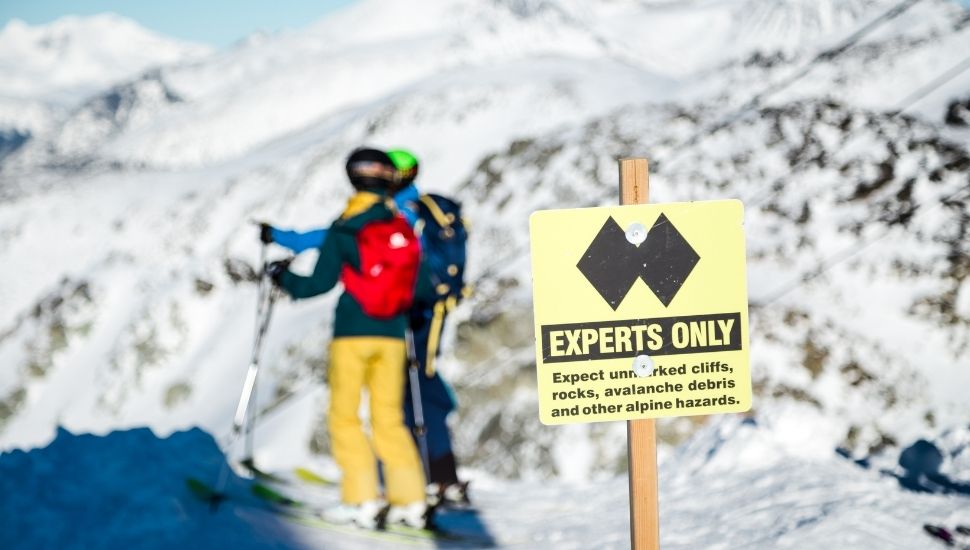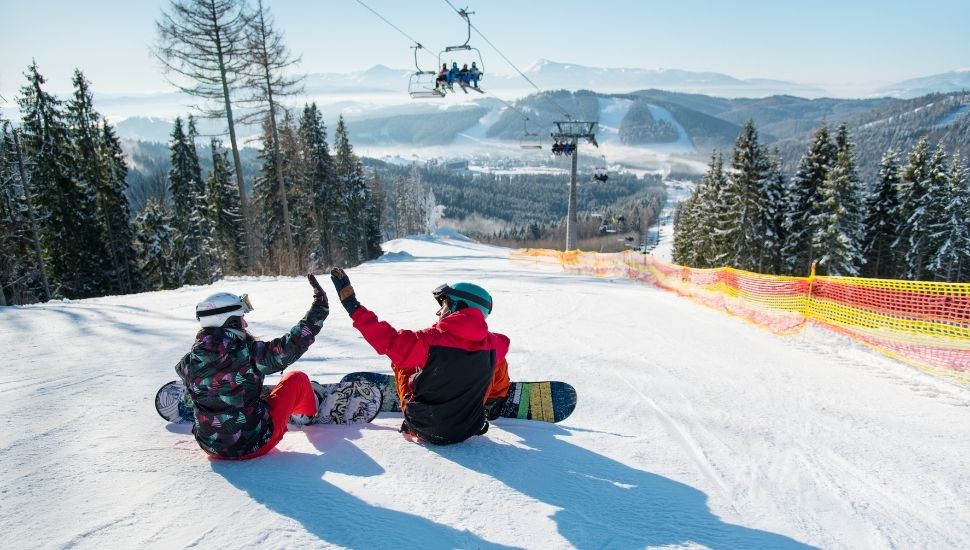Ski Run Colours Guide: Blue, Red & Black Ratings Explained
If you're new to winter sports, it's critical to understand the ski hill ratings so you don't end up on stretches of snow that you're unable to handle.
It goes without saying that a novice skier should not attempt a red or black run, let alone a double or triple black!
Black, red, blue, green ski runs: what do they mean?
if you don't familiarise yourself with the ski slope colours, you could end up bruised black and blue - or worse, faced with a bone fracture.
Ski slope ratings: It's all relative
A red run ski slope on one resort might be fairly sedate, while on another resort it might be downright difficult.
That's because ski resorts rate the difficulty of their slopes in relation to other ski slopes at the same resort.
However, the rating system still gives you a good idea of a slope's difficulty.
European and Japanese ski slope ratings
European resorts use colour-based ski hill ratings, with the relative colours on circle-shaped signs.
Japanese signs are similar, but blue slopes (easy) are replaced with green.
Green ski slopes
Beginner in Europe (shallow gradient slopes), or ‘easy’ in Japan (see below).
Blue ski slopes
- Easy runs.
- Less than 25% gradient.
- Normally groomed on shallow slopes.
(Green in japan).
Red ski slopes
- Intermediate runs.
- Under 40% gradient.
- These might be steeper and/or narrower than blue slopes.
- Often groomed.
Black ski slopes
Expert runs. However, they can vary significantly between resorts.
A Black run may only be a little more challenging than a nearby red run, or it may be considerably trickier to navigate.
If you have found a red run punishing, chances are black-slope skiing will be beyond your ability level.
Orange ski slopes
More difficult than black. This ski slope colour is uncommon outside Austria.
Yellow ski slopes
Some European resorts have reclassified black runs to yellow in recent years, they are ungroomed and unpatrolled routes that are actually off-piste areas. However, they are secured from avalanches.
Double or triple black diamond ski slopes
Not to be tried unless you're comfortable on black runs.
Extreme gradients, wind exposure, narrow routes and obstacles such as trees are common.

North American, Australian and New Zealand ski slope ratings
Ski run colours are combined with shapes in the US, Canada, Australia and New Zealand. These are comparable to European/Japanese slope ratings.
Note that there are generally no red runs in these countries.
Green circle runs
Easiest. Suited to absolute beginners: wide, groomed with gradients of between 6% and 25%.
Blue square runs
Intermediate. with gradients of between 25% and 40%, these runs are a little more challenging.
Because these represent the majority of runs, they are often crowded - so there is a higher risk of skier-on-skier collision.
Black diamond runs
Expert. Comparable to European black runs, they are steeper, narrower and present more obstacles than blues.
They are generally ungroomed and have gradients of more than 40%.
Leave the black slope skiing until your skills have improved.
Double-black diamond runs
Even more demanding than black diamond runs, these ski slopes are steeper, narrower, more exposed to wind and feature more obstacles.
if you can’t handle a black diamond ski run, then these should be considered off limits.
Triple-black diamond runs
As you might expect, these ski runs are only for highly experienced, expert skiers.
Attempting them without enough experience is extremely risky.
Orange oblong runs
This denotes a terrain park, where skiers and snowboarders (and snowbikes) can perform tricks on various ramps, jumps and other features.
Scandinavian ski slope ratings
Scandinavian ski slope colours are comparable to the rest of Europe but also use shapes.
Green circle
Very easy. Up to 9° (16%) slope.
Blue square
Easy. Up to 15° (27%) slope.
Red rectangle
Moderately difficult. Up to 25° (47%) slope.
Black diamond
Difficult. Over 25° (47%) slope.
Double-black diamond
Very difficult. Over 25° (47%) slope.
Triple-black diamond
The most difficult. Over 25° (47%) slope.
Used in some areas.

Preparing for your first winter sports holiday
If you haven’t skied or snowboarded before, it’s important to familiarise yourself with the various ski hill ratings at your destination.
But here are some extra tips for having a safe trip on your winter sports holiday:
- Improve your fitness - you’ll be using muscle groups you don’t exercise in everyday life. Carrying out certain exercises like squats in the weeks before your trip will help you have a more enjoyable trip and avoid injury.
- Ensure your equipment fits you well - it’s much harder to enjoy yourself if your boots or other equipment don’t fit properly.
- Dress for the cold - even if a day starts out bright, conditions on the mountain can change quickly.
- Stay hydrated - just because you're surrounded by solidified water, doesn’t mean you don't need to keep your H20 levels topped up.
- Stick to the beginner runs - don’t be tempted to jump before you can stay upright down a blue run.
- Skiing with friends - it’s always good to have someone by your side should something go wrong.
- Pay attention to signs - another reason to familiarise yourself with the ski run colours on this page.
Taking out appropriate winter sports travel insurance
Whatever your level of experience on the slopes, it's critical you take out appropriate travel insurance for your holiday.
If you’re planning on participating in any winter sports activities you'll need to add Winter Sports Cover.
Winter sports travel insurance cover from Start Travel includes on-piste and off-piste skiing.
If you get injured while undertaking winter sports you could be landed with a large medical and/or evacuation bill.
But with the right winter sports travel insurance cover, you can rest assured you’ll get the attention you need, if the worst happens.
Start Travel Winter Sports Insurance
Here at Start Travel we want you to have complete peace of mind while enjoying your next winter sports break.
That’s why, on top of all the benefits of our standard travel policy, with our Winter Sports insurance option you'll benefit from:
- 24-hour emergency medical assistance.
- Cover up to a total amount of £1,000 for your equipment (depending on the level of cover you select).
- Available on single trip policies.
- Annual multi-trip winter sports insurance covers you up to 24 days in total per year.
- Includes Piste Closure up to £600 when there is a lack of snow and your resort closes between 1st December to 30th April.
- Coverage if your trip is disrupted due to a direct result of an avalanche up to £600.
- Available for customers aged up to 64.